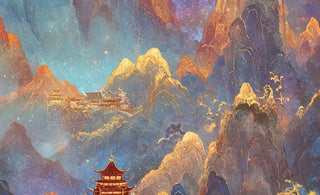
In the vast expanse of artistic expression, the realm of Oriental aesthetics stands as a testament to the intricate interweaving of diverse cultures throughout history. Originating from the cradle of ancient civilizations, Oriental aesthetics transcends temporal and spatial boundaries, encapsulating a harmonious fusion of art, spirituality, and daily life. This essay delves into the profound confluence of cultures within Oriental aesthetics, examining the synthesis of traditional elements and their evolution in contemporary contexts, all while maintaining a captivating and universal appeal.
The Essence of Oriental Aesthetics
Central to the tapestry of Oriental aesthetics is a delicate dance between simplicity and complexity, wherein every stroke, hue, and form is imbued with profound significance. This interplay is the essence of a visual language that extends beyond the confines of linguistic and cultural boundaries. Rooted in a profound connection with nature, philosophy, and spiritual ideologies, Oriental art becomes a vessel for encapsulating the transient beauty intrinsic to existence.
The deliberate use of negative space, an artful mastery of intricate brushwork, and the inclusion of symbolic motifs contribute to the creation of this visual language. Negative space, rather than being an absence, becomes a powerful presence, allowing the observer to engage in contemplation and interpretation. The brushwork, whether bold and expressive or delicate and restrained, serves as a conduit for emotions and ideas. Symbolic motifs, drawn from a rich cultural reservoir, convey layers of meaning that resonate universally, transcending linguistic and cultural barriers.
In the canvas of Oriental aesthetics, each artistic element becomes a brushstroke in a larger narrative, a story told through visual poetry. This narrative is not confined to a singular cultural context but becomes a shared experience, inviting individuals from diverse backgrounds to appreciate and contemplate the universal beauty woven into the fabric of Oriental art. It is in this nuanced interplay, where simplicity converges with complexity, that the timeless allure and cross-cultural resonance of Oriental aesthetics truly come to life.
The Intersection of East and West
Navigating the crossroads of East and West, artists find inspiration in the harmonization of contrasting elements. The synthesis of traditional Oriental motifs with contemporary Western techniques creates a dialogue that transcends geographical boundaries. This artistic amalgamation manifests through the fusion of calligraphy with abstract expressionism and the juxtaposition of ancient symbolism with modern concepts. The resultant visual language resonates globally, fostering an appreciation that defies cultural confines and speaks to a shared human experience.
Spirituality and Symbolism
Deeply entrenched in spirituality and symbolism, Oriental aesthetics serves as a conduit for metaphysical exploration. The symbolism inherent in ancient myths, religious iconography, and philosophical doctrines is a testament to the profound connection between the material and the transcendent. The ethereal dance of yin and yang, the auspicious symbolism of the lotus flower, and the timeless beauty embodied by the crane in flight are universal symbols that traverse cultural boundaries, weaving a tapestry of shared meanings.
Tradition in a Contemporary Context
The evolution of Oriental aesthetics within contemporary contexts involves infusing traditional elements with a modern sensibility. Drawing inspiration from classical art forms such as ink wash painting and traditional woodblock printing, artists reinterpret these techniques to breathe new life into age-old traditions. This dynamic approach presents Oriental aesthetics as a living, evolving force that resonates with contemporary audiences, ensuring the preservation of cultural heritage while embracing the spirit of innovation.
The Global Relevance of Oriental Aesthetics
The exploration of the confluence of cultures in Oriental aesthetics is not confined to a particular time or place; it is a celebration of diversity with a universal resonance. As the world becomes increasingly interconnected, the allure of Oriental aesthetics finds itself woven into the fabric of a global cultural tapestry. The intersection of East and West is not merely a meeting point but a symbiotic exchange that enriches both traditions, fostering a cross-cultural understanding that transcends regional differences.
Art as a Cross-Cultural Communicator
Art, as a potent medium, transcends linguistic and cultural barriers, serving as a dynamic vehicle for cross-cultural communication. Within this expansive realm, Oriental aesthetics emerges as a quintessential exemplar, possessing a remarkable capacity to articulate intricate ideas and profound emotions without the need for verbal language. The visual tapestry meticulously woven by artists navigating the confluence of cultures transforms into a shared space, inviting individuals from diverse backgrounds to partake in a nuanced and meaningful dialogue.
This artistic dialogue goes beyond mere visual appreciation; it cultivates a deep-seated understanding and connection among individuals who may hail from disparate cultural landscapes. The beauty that emerges from the fusion of traditions within Oriental aesthetics becomes a unifying force, encouraging a collective exploration of the rich artistic heritage it embodies. In this shared space, the nuances of brush strokes, the symbolism embedded in motifs, and the synthesis of East and West become a universal language, fostering an environment where cultural diversity is celebrated and where the profound essence of humanity is communicated through the universal language of art. The ability of Oriental aesthetics to evoke such cross-cultural conversations underscores its significance as a bridge that connects, enlightens, and unites a global audience in appreciation of the profound beauty born from the intermingling of diverse traditions.
Conclusion
In conclusion, the exploration of the confluence of cultures in Oriental aesthetics is a journey that transcends the boundaries of time, space, and individual perspectives. The intricate dance between simplicity and complexity, the harmonization of East and West, the deep spiritual connections, and the dynamic evolution of tradition in a contemporary context all contribute to the enduring appeal of Oriental aesthetics. As we navigate an ever-changing global landscape, the profound beauty that emerges from the confluence of cultures within Oriental aesthetics continues to inspire, captivate, and unite a diverse and interconnected world.
























